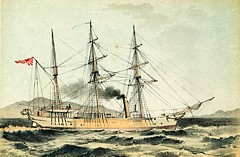Japanese warship Hōshō

Painting of Hōshō from 1895 book
|
|
| History | |
|---|---|
| Name: | Hōshō |
| Builder: | United Kingdom |
| Laid down: | 1868 |
| Launched: | 1868 |
| Completed: | 1869 |
| Commissioned: | July 4, 1871 |
| Out of service: | 1898 |
| Struck: | April 19, 1906 |
| Fate: | Scrapped April 9, 1907 |
| General characteristics | |
| Displacement: | 321 long tons (326 t) |
| Length: | 35.7 m (117 ft) |
| Beam: | 7.37 m (24 ft 2 in) |
| Draught: | 2.44 m (8 ft) |
| Propulsion: |
|
| Speed: | 11 knots (13 mph; 20 km/h) |
| Range: | 810 tons charcoal |
| Complement: | 65 |
| Armament: |
|
Hōshō (鳳翔?) was a screw sloop, originally built in the United Kingdom for Chōshū Domain in western Japan, and subsequently served in the early Imperial Japanese Navy. Its name can be translated as "flying phoenix".
Hōshō was built in 1868 in Aberdeen, Scotland as a wooden-hulled three-masted bark-rigged sloop-of-war with a coal-fired triple expansion reciprocating steam engine with two boilers driving a single screw. She arrived in Japan in 1869, and was named Hōshō Maru (鳳翔 丸?) by Chōshū Domain authorities. She served during the Boshin War of the Meiji Restoration, and was famous for allowing 330 Satsuma ronin agitators to escape from Shinagawa, Edo in January 1868, despite efforts by the Tokugawa shogunate to prevent their escape. She was transferred to the fledgling Imperial Japanese Navy on May 15, 1871.
On June 8, 1871, the Meiji government renamed the vessel Hōshō . The ship was sent to support government operations during the Saga Rebellion in 1874, and was one of the ships in the Japanese fleet during the Taiwan Expedition of 1874. In 1877, Hōshō provided support to government forces during the Satsuma Rebellion.
...
Wikipedia
